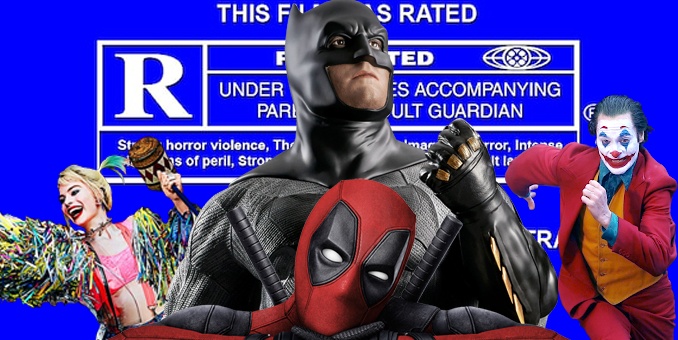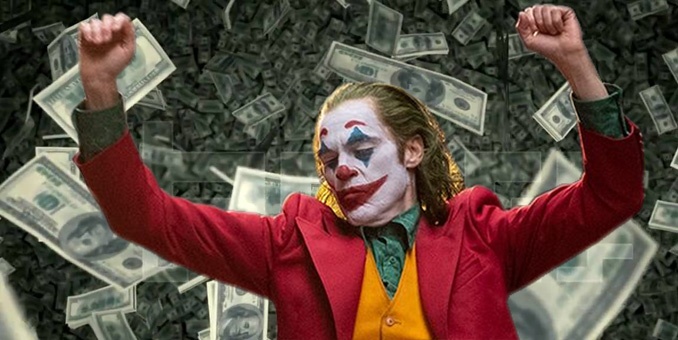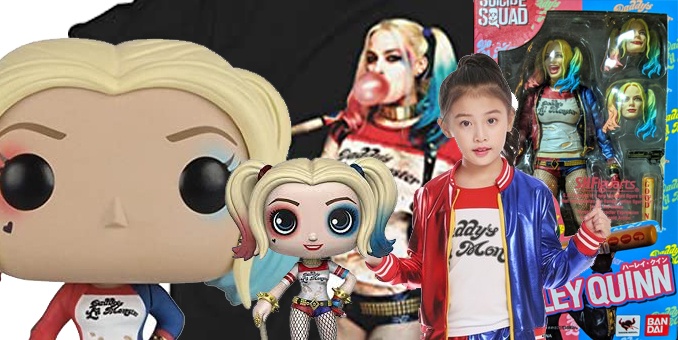
“Here’s one piece of information nobody knows: The movie is insane and so epic and is probably rated R — that’s one thing I think will happen, that it will be an R-rated version, for sure. We haven’t heard from the MPAA, but that’s my gut. There’s one scene where Batman drops an F-bomb. Cyborg is not too happy with what’s going on with his life before he meets the Justice League, and he tends to speak his mind. And Steppenwolf is pretty much just hacking people in half. So [the rating would be due to] violence and profanity, probably both.”
That quote comes from Zack Snyder from his recent interview with Entertainment Weekly about the upcoming Snyder Cut of Justice League. It is causing quite a stir across social media. And the unabashed glee in which Snyder relates that Batman will say the F-word, like a 6th grader finding bad words in a dictionary (“Look! Penis! Tee Hee!”) pretty much sums up a developing problem in the world of superhero films: an over reliance on R-Rated films and their popularity.
R-Rated superhero films are nothing new. They date back to 1994’s The Crow and 1998’s Blade. But they were a dodgy proposition. Disappointing R-Rated films such as Punisher: War Zone (2008), Watchmen (2009), and Dredd (2012) made studios hesitant to go above PG-13 with their superhero films.
However, with the success of 2016’s Deadpool and 2017’s Logan showed there is money is those R-Rated hills, and many studios not named Marvel aim to capitalize with their superhero properties. But the studio in the forefront of the R-Rated superhero trend, Warner Brothers, is perhaps the one least suited to take advantage of this trend, as the Zack Snyder news shows.
Warner Brothers, in case you didn’t know, owns DC Comics. DC Comics is the Cadillac of comic book companies. Without them, and a little character called Superman they introduced in 1938, comic books would not be the domain of the superhero. They have thousands of characters, a wide ocean of IP property, that screams to be adapted to other media.
Unfortunately, parent company Warner Brothers seems to have very little idea how to consistently adapt these properties into successful films, especially of late. And when they have successes, they can’t see the nuances that make them succeed.
I first noticed this back in 2011. Then film group president Jeff Robinov was discussing what went wrong with 2010’s disappointing Green Lantern and what they would fix with its then planned sequel:
“We had a decent opening so we learned there is an audience,” said Warner Bros. film group President Jeff Robinov, pointing to the film’s box office debut of $53 million. “To go forward we need to make it a little edgier and darker with more emphasis on action…. And we have to find a way to balance the time the movie spends in space versus on Earth.”
The “edgier and darker” tact was obviously influenced by the success of the edgy and dark The Dark Knight, which made over a billion dollars worldwide just a few years prior. And the fact that Warners would go down that route shows how tone deaf they are in two ways. First, that the success of The Dark Knight is due solely to its dark and gritty tone and not to the fact that it was a quality script delivered by Oscar-caliber actors directed by an Oscar-caliber director that stay close to the source material while adding a new take to draw audiences in. And, second, that an interstellar cop with a magic ring that allows him to make solid constructs out of whatever he can imagine lends itself to a dark and gritty portrayal.
Warners was wrong on both accounts but that didn’t stop them from going darker and grittier. There was no sequel to Green Lantern, but the studio decided to go heavier with with their Superman reboot, Man of Steel, directed by Snyder, which ended Superman breaking a bad guy’s neck. Snyder doubled down with Batman v. Superman: Dawn of Justice, where Batman spent the entire movie relentlessly determined to murder Superman, killing everyone who stood in his way, only to be swayed by finding out his mother and Superman’s mom had the same name. By comparison, Suicide Squad, a DC Comics film about cold-blooded killers drafted into government service, seemed like a joyful walk in the park.
Warners was surprised when neither Man of Steel nor Batman v. Superman broached the $1 billion dollar plateau, so the studio course corrected with Wonder Woman, Aquaman (which DID make over a billion worldwide) and Shazam!, all of which were lighter and less edgy and all which made a profit. However, the debacle was Justice League, where the studio tried to hone Zack Snyder’s rough edges into their new lighter style for the DC films. The end result was not quite in either camp, but the changes added to an already enormous budget and made it almost impossible for it to make a profit.
This sent Warners scurrying towards another course correction, and the direction they went in was to lean into the R-Rating. After all, Logan and Deadpool became hits not because they were good films, but because they were rated R, right? Well, no, but that is probably what the less-than nuanced thinking of Warners thought. And they unfortunately got the wrong kind of confirmation for this line of thinking when Joker became the most profitable comic book film in history.

After the success of Joker, Warners announced that Birds of Prey: And The Fantabulous Emancipation of One Harley Quinn and The Suicide Squad would be R-Rated. To date, only the former has been released, but it shows the flaws in Warners’ decision to put out R-Rated DC films.
It’s not like Birds of Prey wasn’t always intended to R-Rated. Margot Robbie pitched it to be one from the get go. However, that was a mistake, one that Warner Brother was not interested in correcting.
I have my issues with Joker, but I will say this about that movie–it earned its R Rating. The whole film was immersed in a violent, seedy reality that could only be properly portrayed with an R Rating. Birds of Prey, on the other hand, could have very well worked as PG-13 film if you removed the gore, brutal violence and profanity. Heck, it probably would have worked better considering the wacky, Looney Tunes-esque tone the film had at times.
It probably would have made more money too. Industry estimates say that Birds of Prey lost anywhere from $50 million to $100 million at the box office. Pundits have blamed everything from the current pandemic shortening its theatrical run to the characters not being as well known to the general public to that old chestnut of it being a female led action movie. But if I had a bet, I’d put most of my money on the R-Rating as the reason it was a disappointment.

Birds of Prey was an ipso facto sequel to Suicide Squad, which was rated PG-13. Harley Quinn was the breakout star of that film, and a lot of the merchandise for that film featuring her were aimed at teen and pre-teen girls. If you were 13 in 2016 when Suicide Squad was released, you could conceivably be old enough to go see Birds of Prey in a theater all by yourself. However, if you were younger, or discovered Robbie’s Quinn on its numerous cable airings, you didn’t have that freedom. You might have wanted to see Birds of Prey, but your parent or guardian might not have been so hyped to let you.
Which brings us to Zack Snyder’s Justice League. Now, I’m going to go on the record as saying I’m dubious that the four-hour film will be released in theaters, especially in today’s climate. That seems to be a carrot thrown out by Snyder to spur his loyal followers to action and hopefully make something happen. And if it stays exclusively on HBO Max, it most likely won’t get an MPAA Rating, so any discussion about the recut getting an R rating might be moot.
That being said, I doubt anyone left the theaters after seeing Justice League and said, “You know what would have made that film better? If Batman dropped the F-bomb.” And I’m pretty sure that if anyone was on the fence about signing up for HBO Max, the fact that Steppenwolf will now be hacking people in half isn’t going to be enough to have people running to their computers with their credit cards to sign up.
But Zack Snyder seems to think that they will. You can tell by that pull quote on the top of the page. But ultra-violence and cursing is not the draw he or Warners think it is. I’m more drawn in by the fact that Cyborg’s backstory is going to be explored than Batman’s potty mouth.
Why? Because just because you can make an R-Rated horror movie doesn’t mean you should. I’ve been hammering Warners pretty heavy here, but they are certainly not alone in this area. Take the recent Hellboy reboot. From the very first announcement that it was going to be remade, director Neil Marshall and character creator Mike Mignola trumpeted how it was going to be an R-Rated film, like that would be enough to counter act Guillermo del Toro no longer being involved in the project. Maybe it did to hardcore Hellboy fans, but to audiences and critics, it wasn’t.
This isn’t to say that some characters don’t lend themselves to an R rating. On paper, Hellboy is one of them. But instead of making a property into an R-Rated film in order to draw in customers, filmmakers should focus more on writing a good story first, or at least knowing your target audience. That would work better than naughty words and spewing blood.




